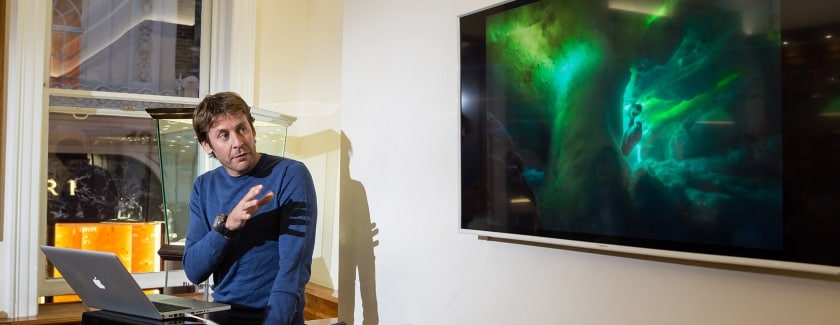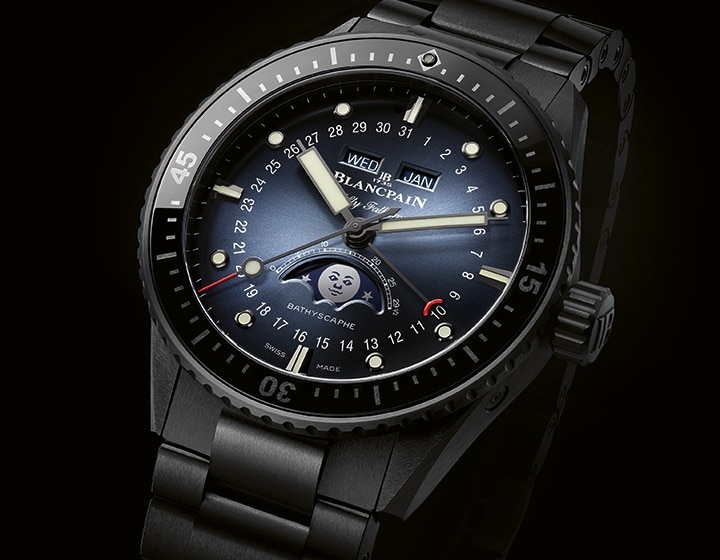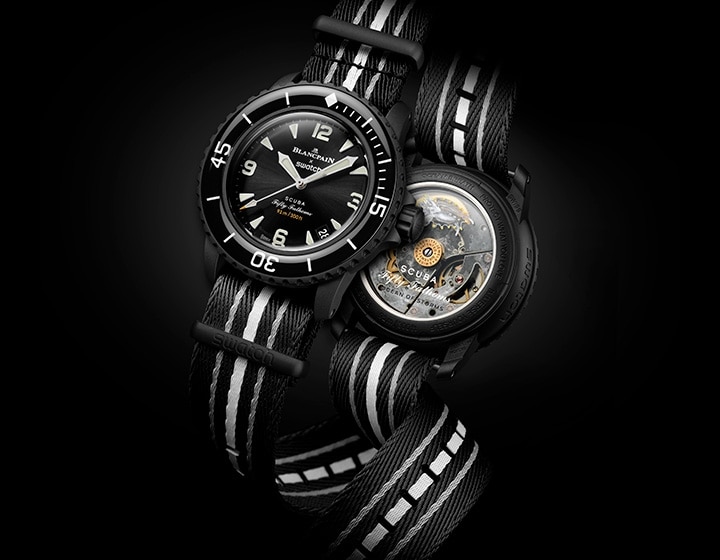Laurent Ballesta wins the Wildlife Photographer of the Year

Since 2013 and the quest for the coelacanth, Blancpain is the main partner of Laurent Ballesta and his Gombessa Project. His winning photograph in the Wildlife Photographer of the Year "Earth's Environments" category was shot during the Gombessa III – Antarctica! expedition and shows for the first time the entire submerged part of an iceberg. Congratulations Laurent!
Now in its 53rd year, Wildlife Photographer of the Year is the longest-running and most prestigious nature photography competition in the world. It is owned and run by the Natural History Museum in London. The competition uses photography to challenge perceptions about the natural world, helping to promote sustainability and the conservation of wildlife. The "Earth's Environments" category celebrates the scale and magnitude of Earth’s landforms, the natural forces sculpting them or pure wilderness on a landscape scale. Laurent Ballesta's iceberg photograph, the result of many hours of work during dives in freezing water temperatures, fits perfectly in this description. With the conviction that public awareness is vital to achieve the goal of preserving the world’s oceans, Blancpain is delighted about this well deserved distinction rewarding Laurent's talent as well as the exceptional photographic work done in the context of the Gombessa Project.
About Laurent Ballesta and the Gombessa Project
Laurent Ballesta is a marine scientist, a distinguished underwater photographer and a pioneer in the use of new diving equipment. Blancpain’s support has enabled him to capitalize on his talents through the Gombessa Project which has been conceived to advance the public’s comprehension of hitherto inaccessible and dimly understood undersea ecosystems. The project has already given rise to four major expeditions. With Gombessa III, Blancpain and Laurent Ballesta traveled to Antarctica for a pioneering exploratory, diving and photographic mission, in collaboration with Luc Jacquet, producer of The March of the Penguins. It was the first time a team of technical divers had been able to go beneath the sea ice in this region to deliver the very first naturalist images of Antarctica’s deep-sea ecosystems. At the request of several research groups, the team contributed to the inventory of deep-sea fauna and gave researchers access to all their photographs for the purpose of scientific publications.
About Blancpain's Ocean Commitment
Driven by a resolutely pioneering spirit since its founding in 1735, the Manufacture Blancpain has enjoyed historical links with diving for more than 60 years, more precisely since the 1953 launch of the Fifty Fathoms, the world’s first modern diving watch. In recognition of this heritage, Blancpain is committed to the exploration and preservation of the oceans. Convinced that support for environmental protection is directly dependent on keeping the public informed, the Manufacture works to raise overall awareness by sponsoring significant scientific projects, ocean exploration initiatives, underwater photography, environmental forums, exhibitions, high- profile publications and a dedicated website. Since the collaborative gathering of all its partnerships in the realm of ocean exploration and preservation under the Blancpain Ocean Commitment label in 2014, Blancpain has co-financed eleven major scientific expeditions, and presented several award-winning documentary films, exhibitions and publications. The Manufacture is particularly proud of its contribution to doubling the surface of marine protected areas around the world with the addition of more than four million square kilometers of newly protected ocean.
The story behind the hidden face of the iceberg photograph, by Laurent Ballesta
“The Furious Fifties are behind us and the Astrolabe is approaching the Antarctic continent by sailing through the calm, open waters of the polynya. We are not alone, as ice giants stud the smooth expanse to unbelievable heights. In fact, the scene has to be seen to be believed, because how can one possibly conceive that mountains can float? A few kilometers from the French Dumont d’Urville base, they mark the entrance to Adelie Land… We glide silently past them, feeling like tiny specks on our 65 m long boat, while bearing in mind that we can only see 10% of their volume. Under the surface, these gigantic ice masses are invisible. Although there are plenty of “fakes” on the web, along with computer-generated images and far-fetched tales, no one has ever been able to view a whole iceberg at once, much less take a picture of one. Poor visibility, darkness, freezing water, inaccessible depths: countless obstacles have managed to keep secret this submerged side, the hidden face of the planet of ice. At this point, after 11 days of a difficult crossing, I have a sudden fantasy: could one possibly reveal the entire iceberg?
The idea gains momentum. We have been diving for three weeks and each evening when we return we are one step closer to exhaustion. Today’s dive revealed a spherical iceberg, with a circumference of around 200 m, floating above the seabed. It is perfectly still because it is imprisoned by the ice floe, so there is no risk of it drifting or turning sharply. Polished by the current, it looks like a giant pebble. I present my strategy to my mates, who despite being somewhat perplexed, are all for the new idea. This is no simple task, but it’s worth a try.
The following day, we dive in alongside the ice slope. Once on the seabed, we implement the plan: with the halyards weighted to the sea floor and all our surface marker buoys on reels, we establish a huge grid with thread over the entire depth of the water in order to take around a hundred photographs at equal distances from the iceberg.
Several hours and a few frozen toes later, we are sitting in front of the computer which is churning through and digesting the set of photographs. Under the water, none of us were able to see the entire iceberg: viewed from too close up, it extends beyond the scope of our field of view; while from too great a distance it vanishes into the thick mists of the water. Nonetheless, after a few minutes of waiting, it finally appears on the screen: seen in its entirety for the very first time. A much-dreamt-of vision transformed into a reality. Romain Gary’s thought springs to mind: ‘Nothing is worth living that is not first a figment of the imagination, or else the sea would be nothing more than salt water.’.”
Additional notes about the Wildlife Photographer of the Year
Wildlife Photographer of the Year celebrates biodiversity, evolution and the origins of life, and aims to inspire a greater understanding of nature. The competition champions ethical wildlife photography. This means it advocates faithful representations of the natural world that are free from excessive digital manipulation, accompanied by honest captions and that display total respect for animals and their environments. The associated exhibition premieres at London's Natural History Museum each year and tours more than 60 cities in the UK and across the world.
Related news

Blancpain Fifty Fathoms
Born from an icon that has shaped the history of watchmaking, the Fifty Fathoms Automatique 42mm in stainless steel joins Blancpain's permanent collection. Following the success of the 2023 limited edition, the Fifty Fathoms 70th Anniversary Act 1, and the brushed grade 23 titanium and red gold versions launched last year, this new model pays…

Blancpain Bathyscaphe Quantième Complet Phases de Lune
Blancpain is delighted to present the new Bathyscaphe Quantième Complet Phases de Lune, now fitted with an elaborately designed and patented black ceramic bracelet and a case made from the same material. With an assertive, sporty yet supremely elegant style, this model features a dial in vibrant shades of sunray-brushed blue. Available with a…

Swatch Ocean of Storms
A new ocean is joining the five watches and five oceans in the Blancpain X Swatch collaboration. Even though planet Earth only has five, Swatch is welcoming OCEAN OF STORMS into its Bioceramic Scuba Fifty Fathoms Collection that celebrates Blancpain’s iconic Fifty Fathoms, a watch that revolutionized watchmaking by becoming the first true diver’s…

